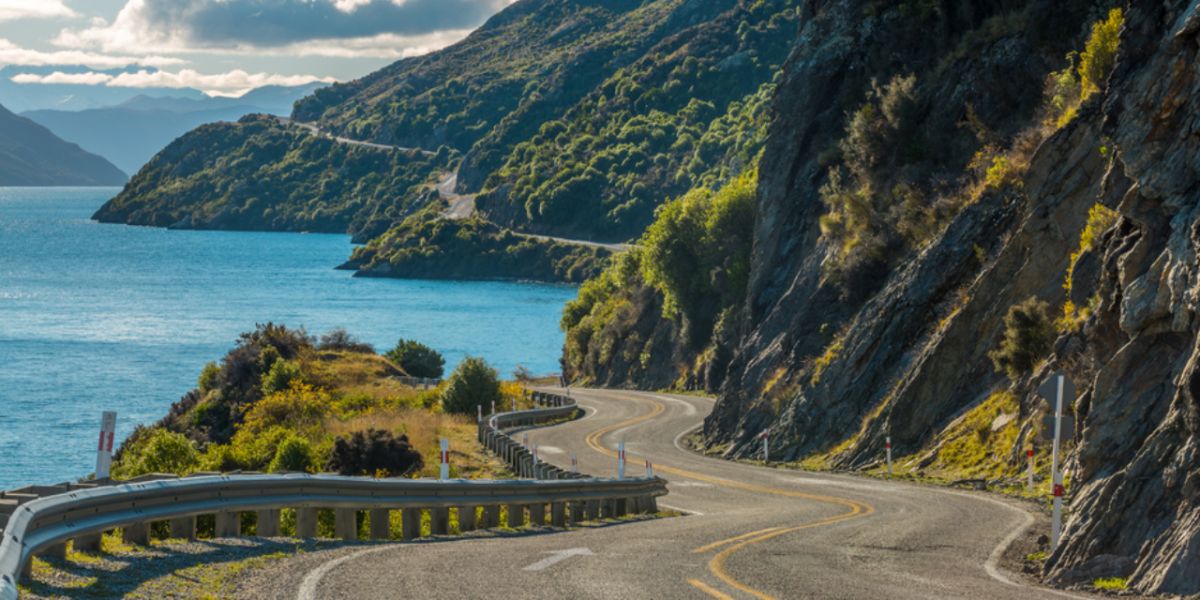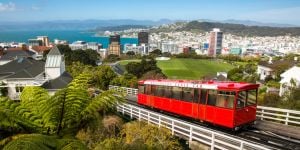
There's no point going all the way to New Zealand and not exploring it as much as possible once you're there. Whether you're in the country for a few months or planning to stay longer, there are some unique things to consider when figuring out how to get around New Zealand.
Although New Zealand is a relatively small country, distances between major cities and towns can be significant, and bus and train travel is limited in small or remote towns. It is important to consider how far you will need to travel and whether it is practical to use a particular mode of transportation for your journey. Read on to discover some of the best ways to get around when in Aotearoa.
Planes in New Zealand
Planes are by far the fastest way to get around New Zealand. Larger cities, smaller towns and even some islands have domestic airports. Air New Zealand is the leading domestic carrier, although Jetstar and Origin Air have stepped up in recent years to cover more of the country. Domestic flight deals do come up occasionally (Grabaseat is a great place to check), and you are generally guaranteed to find cheaper flights if booking far in advance. Smaller airlines also cover some of the more remote destinations in New Zealand and can occasionally be more affordable than the mainstream carriers.
When traveling by plane in New Zealand, it is important to arrive at the airport plenty of time ahead of your flight. Domestic airports in the larger cities have security screening and baggage checks, whereas, in the smaller cities, you are often able to simply drop off your bag and proceed to the gate. It is also a good idea to familiarize yourself with the baggage allowance and any other restrictions that may apply to your flight. Most airlines have weight and size limits for carry-on and checked baggage, and there may be additional fees for excess baggage.
Trains in New Zealand
Compared to other countries, train travel is fairly limited in New Zealand, and some train lines are for freight only. However, there are a number of passenger train services operating throughout the country. The national rail operator is KiwiRail, which operates a network of railways that connect some major cities and towns. The main trunk line runs from Wellington in the south to Auckland in the north, with branches to other destinations such as Hamilton, Tauranga, and New Plymouth.
Auckland also has its metro rail, which connects the suburbs with the inner city, and, in Wellington, some people choose to commute via rail from the outer suburbs into the city.
There are also a number of scenic rail journeys available in New Zealand, which offer passengers the opportunity to experience the country's natural beauty and diverse landscapes. These include the TranzAlpine, which travels through the Southern Alps from Christchurch to Greymouth, and the Northern Explorer, which travels from Auckland to Wellington through the central North Island.
Ferries in New Zealand
The main ferry service between the North and South Islands of New Zealand is operated by two companies: Bluebridge and Interislander. Both companies offer regular ferry services between Wellington on the North Island and Picton on the South Island and come with similar price tags, although Bluebridge does come in slightly cheaper.
The journey across the Cook Strait, which is the body of water that separates the two islands, takes around three hours and is known for its beautiful scenery, although it can be rough, so if you are prone to seasickness, make sure to check the forecast and prepare with motion sickness medicine in advance. The ferries have comfortable seating, toilets, food and drinks, and sometimes additional facilities such as cinemas and play areas for children. Both Interislander and Bluebridge ferries have space for vehicles, allowing passengers to bring their cars, motorcycles, or other vehicles with them on the journey.
Ferries are also a popular way to access some of New Zealand's islands, including Waiheke Island off of Auckland, Great Barrier, and Stewart Island/Rakiura.
Buses in New Zealand
Bus travel is a popular and convenient way to get around New Zealand, with a number of companies operating domestic and long-distance services throughout the country. The main bus operator in New Zealand is InterCity, which operates a network of services connecting major cities and towns. Other companies, such as Naked Bus and ManaBus, also offer budget bus services on a range of routes.
Bus travel is also popular in New Zealand's larger cities, and if you are based in one of these, it makes sense to buy a travel card specific to your city's public transport network. In Wellington, the Snapper card is a popular way to pay for bus and rail travel. In Auckland, the HOP card is a prepaid card that can be used to pay for bus, train, and ferry travel in the region. The card can be loaded with credit and used to pay for trips by simply tapping it on a card reader when boarding the bus or other public transport. In Christchurch, the Metrocard is a similar prepaid card that can be used to pay for bus travel within the city.
Cars in New Zealand
If you prefer having a private vehicle to get around, then you may want to consider hiring or purchasing a car. Although it isn't the most environmental-friendly option, it's definitely the most convenient when it comes to traveling in New Zealand. Car ownership is very common in Aotearoa – with the latest New Zealand census finding that 92.1 percent of households had at least one car, making Kiwi car ownership rates some of the highest in the world. Many parts of New Zealand will be much more difficult to access if you are relying on public transport, so renting or buying a car is common practice when trying to see as much of New Zealand as possible. Check out our Driving in New Zealand article before you hit the road for more information about licensing, road rules, and how to go about acquiring a vehicle.
Cycling in New Zealand
Cycling is a popular and convenient way to get around in New Zealand, particularly in urban areas where distances are relatively short. The country has a number of bike paths and dedicated cycling lanes in cities and towns, which make it easier and safer for people to cycle to work or other destinations.
Larger towns in New Zealand offer bike-sharing schemes, which allow people to rent bikes for short periods of time and return them to designated stations when they are finished. These schemes can be a convenient and affordable way for people to get around without having to own a bike themselves.
In terms of feasibility for commuting, cycling can be a practical and healthy way to get to work or other destinations in New Zealand, particularly if you live in a flat or relatively small urban area.
Urban public transport in New Zealand
If you plan to live in Auckland, Wellington, or Christchurch, then there will be reliable public transportation options available for you, such as buses, commuter trains, and even ferries. Smaller towns and centers have less frequent public transport options, although many towns do provide some form of bus service. Taxis and ride-share services are commonly used in larger centers, and Uber, Lyft and Ola can be useful apps to have when seeking a ride outside of public transport hours.
We do our best to provide accurate and up to date information. However, if you have noticed any inaccuracies in this article, please let us know in the comments section below.








